Canada's particle accelerator centre
Centre canadien d'accélération des particules
|
Canada's particle accelerator centre | |
μSR Beamlines at TRIUMF | |

The current CMMS μSR facility consists of two heavily subscribed "surface" muon beamlines (M15 and M20). A third surface muon beamline (M9A) is nearing completion with commissioning in Fall 2022. Each surface muon beamline transfers positive muons (μ+) emitted from the decay of positive pions (π+) decaying at rest near the surface of a production target (1AT1 or 1AT2) in the main proton beamline (BL1A) to an experimental area. These surface muon beams are nearly 100 % spin-polarized; have a low momentum of 29.5 MeV/c, which corresponds to a kinetic energy of 4.1 MeV; have a stopping range in matter of the order of 180 mg/cm2. Thus, the M9A, M15 and M20 muon beamlines are particularly suited for the study of relatively thin samples. A decay muon beamline (M9H) is currently under construction with beam expected in 2024. This will supply both positive and negative muons (μ-) with momenta between 40 and 105 MeV/c. These high-momentum muons can penetrate the walls of a pressure cell and will be used to study materials under high pressure. The negative muons will be used for non-destructive elemental analysis.
Beamline |
Type |
Counting Room |
Description |
|---|---|---|---|
M15 |
Surface μ+ | 604-222-7452 | M15 was built in 1985 and prior to the rebuilding of M20 (see below) was the most requested muon beamline by CMMS users. The M15 beamline is dedicated to surface μ+ taken from the 1AT1 proton target, which is usually 1cm graphite or beryllium. Beam is collected by a permanent quadrupole doublet located very close to 1AT1. This gives good muon collection, but limits the momentum range of the channel from about 19 MeV/c to 40 MeV/c. M15 is equipped with dual spin-rotators (Wien filters), which serve both to separate positrons from the beam and to rotate the muon spin perpendicular to the beam direction. After transporting the beam up above the level of most other beamlines, M15 produces a high-luminosity focus in the M15 experimental area, which is not actually in the meson hall. M15 has slits for selecting the beam momentum acceptance and adjusting the final spot size. In recent years failures of various components of M15's aging infrastructure has resulted in lost beam time. In 2015, the original power supplies for the quadrupole magnets were replaced at a cost of ~$80k and ~ 8 people months of work. The DR, NuTime and Helios spectrometers are usually installed on M15. |
M20 |
Surface μ+ | 604-222-7380 | M20 takes muons from the 1AT2 target, typically 10 cm beryllium, and delivers a high flux of surface muons. M20 was completely rebuilt with funds awarded in 2006 from CFI, BCKDF and TRIUMF. The M20 project was successfully completed and commissioned to deliver the first beam for experiments in October 2012. The upgrade included several new features: dual achromatic spin rotators and a septum dipole magnet that directs the beam into two distinct experimental areas, each with its own spectrometer. M20 provides reliability; enhanced optics; full spin rotation and dual end-stations enabling extended periods of spectrometer installation; and reduced stoppage time for experimental changeovers. The LAMPF spectrometer is permanently installed on the M20D leg. |
M9A |
Surface μ+ | 604-222-7379 | M9A has been built to alleviate user demand, service a broader user base with advanced beams, and support new faculty hires in Canada. The M9A beamline is equipped with an ultra-fast electrostatic kicker for MORE capability and dual achromatic spin rotators. The completion of M9A was significantly delayed by a vacuum leak in the high radiation area where M9A connects to the 1AT2 primary target along the main beamline (B1A), but this was repaired and a new radiation resistant quadrupole front end magnet (Q1) was installed. Commissioning is expected in Fall 2022. |
M9H |
Backward μ+/μ- | 604-222-7379 | The M9H beamline will have a persistent superconducting solenoid, where pions will decay in flight to produce high-energy μ+ and μ-. The persistent solenoid will ensure a very high operational reliability, as it is essentially impervious to temporary power losses, and the modern design using recondensers and pulse tube coolers will minimize the operational overhead required from TRIUMF cryogenic personnel. The M9H beamline will be optimized for transverse-field (TF) μSR measurements at all practical muon energies, providing capabilities not available elsewhere in the world. A new spectrometer centred on a 4 T superconducting omnidirectional Helmholtz magnet will accommodate a dilution refrigerator specifically adapted for high-pressure cell experimental targets (≤ 2.5 GPa) for studies of quantum materials at milliKelvin temperatures. M9H will also support the insertion of high-pressure liquid or gas target sample cells under extreme conditions (temperatures ≤ 1000 K and pressures ≤ 0.6 GPa). |
|
Centre for Molecular and Materials Science |
CMMS User Liaison Scientist |